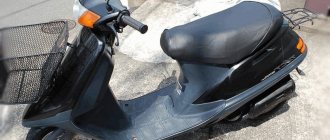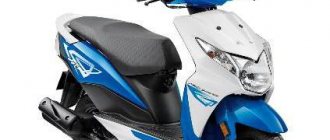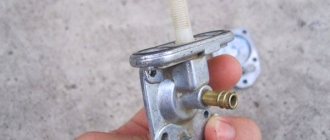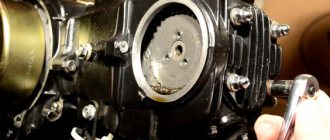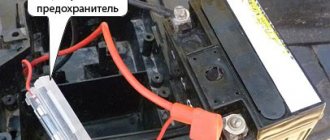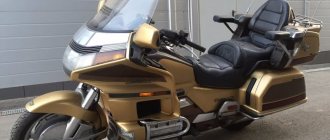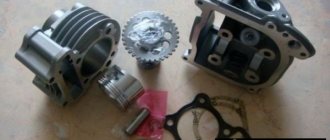To improve tire performance, increase engine efficiency, and ensure road stability, it is necessary to maintain the correct tire pressure. They are designed in such a way that their shape must be maintained by internal pressure. If a tire is inflated correctly, it wears evenly and there is no deformation of the tread or sidewall of the tire.
An overinflated tire has a smaller contact patch, which negatively affects directional stability, especially when cornering. The center portion of the tread will experience the most wear. The tire becomes very rigid and transfers vibrations from bumps on the road more strongly to the body of the scooter. The suspension suffers: bearings and silent blocks, as well as shock absorbers.
If the tire is underinflated, then the grip on the road is also insufficient, wear occurs on the side parts of the tread. Due to increased friction, the tire overheats, which leads to the destruction of the carcass. A 20% lack of pressure results in a 30% reduction in tire service life. In addition, rolling resistance increases, resulting in increased fuel consumption.
Therefore, the pressure must be maintained at the recommended level. If the tire fits well to the rim and has no punctures, then it practically does not deflate. However, the pressure must sometimes be checked, at least visually. If you get on a scooter and the tire is noticeably deformed, it means that it urgently needs to be inflated.
To measure pressure, instruments called pressure gauges are used. They can be mechanical (pointer) or digital electronic. Pressure gauges built into compressors are usually not very accurate. But they are suitable for a scooter.
To how many atmospheres should a scooter wheel be inflated?
The following figures are usually used: the front wheel of a scooter is inflated to 1.8 atm, and the rear wheel - to 2 atm. In winter, the pressure can be reduced by 0.1-0.2 atm.
You should always inflate a “cold” tire, that is, after a long period of inactivity, since when driving it heats up and the pressure increases.
Please note: This article and the images in it are subject to copyright. Partial or complete reproduction on other resources without permission is prohibited.
Read also: Percentage of burnt out lamps in the panel board
How important is it to maintain the correct tire pressure , how to measure it, how often to pump it up, what consequences can there be when driving a scooter on flat tires? These basic rules are important to know, although we often do not attach much importance to them.
Tire pressure monitoring
In fact, you should check the pressure before each trip, not necessarily with a pressure gauge, even just by eye, simply pressing the entire weight of your body on the seat, check if there is a significantly flat tire. The tire may have been punctured or otherwise damaged during your last trip. If this is the case, then be sure to fix the puncture; if you cannot do this manually, inflate the wheel a little more than the recommended rate and go to a tire shop.
Sometimes, when inflating tires, we don’t even think about the standards that must be observed. So, at low pressure , fuel consumption increases significantly, controllability changes dramatically, and the scooter begins to “wobble.” In fact, such behavior of technology is very dangerous, and you should not allow such phenomena. In addition, the service life of the tire and tread itself is significantly reduced. There is a chance of disassembly if it is a tubeless camera. In this case, you will not be able to inflate the tire, even if you took a pump with you. Increased tire pressure also has negative effects on both handling and wear. At the same time, the scooter's grip on the ground decreases, and the slightest unevenness on the road can lead to a fall.
Important: you cannot pump the same pressure into 50cc scooters and maxi scooters. The weight, and therefore the load on the chassis, is different for these scooters.
Excessive pressure also harms the scooter's suspension, which takes almost the entire impact from our roads. The steering column and wheel bearings suffer, and the service life of engine silent blocks and shock absorbers decreases.
Insufficient tire pressure
Depending on the degree of pressure reduction, the motorcycle may “float,” sway, and decrease dynamics. The most dangerous effect is jumping on a weak rear tire, as a result of which you can completely lose control of the car. Rubber wear increases sharply, speed decreases.
Cross-country motorcycles can use these effects to obtain an additional source of extreme sports or when performing various stunts or when riding off-road, however, low pressure in the tires of a Honda sports class motorcycle or other manufacturers can lead to dire consequences, including tire rupture, skidding, spinning body vibration .
Tire pressure gauges
Please note that the pressure gauge must be operational. There have been many cases where Chinese scales showed absolutely inadequate values. Therefore, before you buy such a tool, check it for accuracy by comparing it with a 100% working one.
Read also: %20%D1%e0%f0%e0%f2%ee%e2%f1%ea%e0%ff%20%ee%e1%eb%e0%f1%f2%fc&np2=%c1%e0%e9 %ea%e0%eb
Tire pressure table
On each tire you can find the recommended pressure , which should be adhered to. Typically this is 2 atm at the rear and 1.75 atm at the front. In the table you can find out what pressure should be depending on the tire size.
| Wheel size | Tire pressure, front/rear, kgf/cm2 (atm.) | |
| Normal load | Full load | |
| 100/60-10 | 2,2/2,3 | 2,3/2,4 |
| 130/60-13 | 1,8/2,0 | 2,0/2,2 |
| 130/70-12 | 2,2/2,3 | 2,3/2,4 |
| 120/70-12 | 2,25/2,3 | 2,3/2,4 |
| 110/70-12 | 2,2/2,3 | 2,3/2,4 |
| 120/80-12 | 1,8/2,0 | 2,0/2,2 |
| 130/70-10 | 1,8/2,0 | 2,0/2,2 |
| 100/90-10 | 1,9/2,1 | 2,0/2,2 |
| 120/90-10 | 1,8/2,0 | 2,0/2,2 |
| 130/90-10 | 1,9/2,1 | 2,0/2,2 |
| 3.0x10 | 1,75/2,0 | 2,0/2,1 |
| 3.50x10 4PR | 2,5/2,5 | 2,6/2,6 |
Indicators of air pressure that needs to be pumped into the wheels of popular models of 2T and 4T scooters:
| Model | Front wheel, atm | Rear wheel, atm |
| Moped Alpha 50cc | 1,72 | 2,2 |
| Moped Delta | 1,48 | 2,6 |
| Stealth Zion (as well as other Chinese 150cc scooters) | 1,7 | 2 |
| Honda Dio | 1,6 | 1,97 |
| Honda Tact | 1,58 | 1,95 |
Rules for maintaining optimal tire pressure
To be sure that the tires are inflated correctly, it is necessary to measure the pressure at least every two weeks, and always before each long trip.
If you have not used the moped for a long time, you should also check the pressure gauge readings with the required values. Even at rest, air leakage can occur due to pores in the rubber and the natural technical clearances of the wheel.
The variety of scooter models, differences in their size, weight and load that they are capable of carrying do not allow us to give the same recommendations for optimal tire inflation for mopeds with a capacity of 50, 150, etc. cubes at the same time. Therefore, we suggest you use a specially developed table of tire pressure parameters depending on the technical characteristics of your scooter:
| Tire size | Tire pressure, front/rear, bar | |
| Without load | With load | |
| 100/60-10 | 2.2/2.3 | 2.3/2.4 |
| 130/60-13 | 1 . 8/2 .0 | 2.0/2.2 |
| 130/70-12 | 2.2/2.3 | 2.3/2.4 |
| 120/70-12 | 2.25/2.3 | 2.3/2.4 |
| 110/70-12 | 2.2/2.3 | 2.3/2.4 |
| 120/80-12 | 1.8/2.0 | 2.0/2.2 |
| 130/70-10 | 1.8/2.0 | 2.0/2.2 |
| 100/90-10 | 1.9/2.1 | 2.0/2.2 |
| 120/90-10 | 1.8/2.0 | 2.0/2.2 |
| 130/90-10 | 1.9/2.1 | 2.0/2.2 |
| 3.0x10 | 1.75/2.0 | 2.0/2.1 |
| 3.50x10 4 PR | 2.5/2.5 | 2.6/2.6 |
Important! The parameters indicated on the tire are the maximum permissible value for this rubber. Do not use it as a reference when inflating moped tires.
Tire pressure in winter
If you use the scooter in winter, then it is advisable to reduce the pressure a little. Please also note that when driving, the tire heats up, and these same atmospheres that you measured before the trip will increase slightly. Hence, it is recommended to take measurements when cold. In the cold season, the indicator drops, but the tires also “tanner”.
Many scooter owners who have not previously used this type of equipment do not think about the fact that scooter tires must have a certain degree of pressure. In general, the tire of any vehicle must have optimal performance according to the recommendations, so the scooter must also comply with generally accepted standards. If the pressure in the scooter tires is correct, their service life increases, and the scooter's dynamics and comfort also improve. If the pressure is incorrect, the tire will get an uneven shape.
What pressure should the scooter tires have, and how often should they be checked? In fact, you will have to check the tires before each trip, especially if it is long. It is enough to press well on the seat and see: is the tire flat? During the last movement, the tire could break, and after a long period of inactivity it could simply go flat. In this case, it is recommended to pump up the tire and go to the nearest tire shop.
Read also: Clutch disc MTZ 82
In some cases, we inflate the tire “by eye”, forgetting that it is possible to overinflate it. An overinflated tire becomes hard and is unable to adhere tightly to the surface, that is, the road. This is especially noticeable at high speed and during sharp turns, if the pressure is high, there is a risk of falling.
Also, an overinflated tire will cause rapid wear of the tread, and wear will only occur in the center of the tire. Accordingly, high pressure will not be able to provide good shock absorption; you will feel every hole. This entails further damage to the shock absorbers.
If your tire is flat, the wear will not be on the entire perimeter, but exclusively on the side parts. Also, too close contact with the road makes the scooter move slower, the motor will have to put more load on the wheels, and fuel consumption increases. In general, you can inflate a tire “by eye”, the main thing is that you regularly check its condition. But the tire pressure of a maxi scooter or a 150cc scooter must meet certain indicators, which we will discuss below.
What pressure should the scooter tires have?
Many scooter owners who have not previously used this type of equipment do not think about the fact that scooter tires must have a certain degree of pressure. In general, the tire of any vehicle must have optimal performance according to the recommendations, so the scooter must also comply with generally accepted standards. If the pressure in the scooter tires is correct, their service life increases, and the scooter's dynamics and comfort also improve. If the pressure is incorrect, the tire will get an uneven shape.
What pressure should the scooter tires have, and how often should they be checked? In fact, you will have to check the tires before each trip, especially if it is long. It is enough to press well on the seat and see: is the tire flat? During the last movement, the tire could break, and after a long period of inactivity it could simply go flat. In this case, it is recommended to pump up the tire and go to the nearest tire shop.
In some cases, we inflate the tire “by eye”, forgetting that it is possible to overinflate it. An overinflated tire becomes hard and is unable to adhere tightly to the surface, that is, the road. This is especially noticeable at high speed and during sharp turns, if the pressure is high, there is a risk of falling.
Also, an overinflated tire will cause rapid wear of the tread, and wear will only occur in the center of the tire. Accordingly, high pressure will not be able to provide good shock absorption; you will feel every hole. This entails further damage to the shock absorbers.
If your tire is flat, the wear will not be on the entire perimeter, but exclusively on the side parts. Also, too close contact with the road makes the scooter move slower, the motor will have to put more load on the wheels, and fuel consumption increases. In general, you can inflate a tire “by eye”, the main thing is that you regularly check its condition. But the tire pressure of a maxi scooter or a 150cc scooter must meet certain indicators, which we will discuss below.
Scooter tire pressure: table
To achieve optimal performance, you need to have a pressure gauge; before using it, pay attention to its condition; the device must accurately display the information. As a standard, a scooter tire should have the following pressures:
· Rear wheel - 2 atm;
· Front wheel - 1.75 atm.
Below we have presented a table of optimal pressure; the indicators are affected by the wheel size, weight and size of the scooter. Also keep in mind that when operating the scooter in winter, you will have to lower the tires slightly below the optimal pressure, otherwise the rubber will simply crack from too high an external temperature.
Control: what to measure and what to measure in
Mechanical or electronic pressure gauges are used to measure the pressure in scooter tires. The accuracy class of these devices varies, so it is better not to save money and purchase an expensive but high-quality device. In the future, such a purchase will save you from more significant expenses.
Important! Do not try to gauge tire inflation by squeezing the tire with your fingers. The rigidity of the wheel at a pressure level of more than 1.5 atmospheres is such that it is impossible to determine the true indicators.
There are several accepted units for measuring pressure. On the territory of Russia, the main one is Atmosphere (1 atm. = 1 kgf/sq. cm), which is almost equal to the European Bar (1 bar = 0.98 atm). In the USA, PSI is used (1 psi = 1 pound/square inch or pound/square inch). Tire manufacturers use Kilopascal (1 kPa = 6.895 psi).
Units of measurement are converted into each other using the following formulas:
- 1 psi = 0.068 atm
- 1 atm = 14.696 psi
- 1 atm = 101.348 kPa
- 1 bar = 0.98 atm



